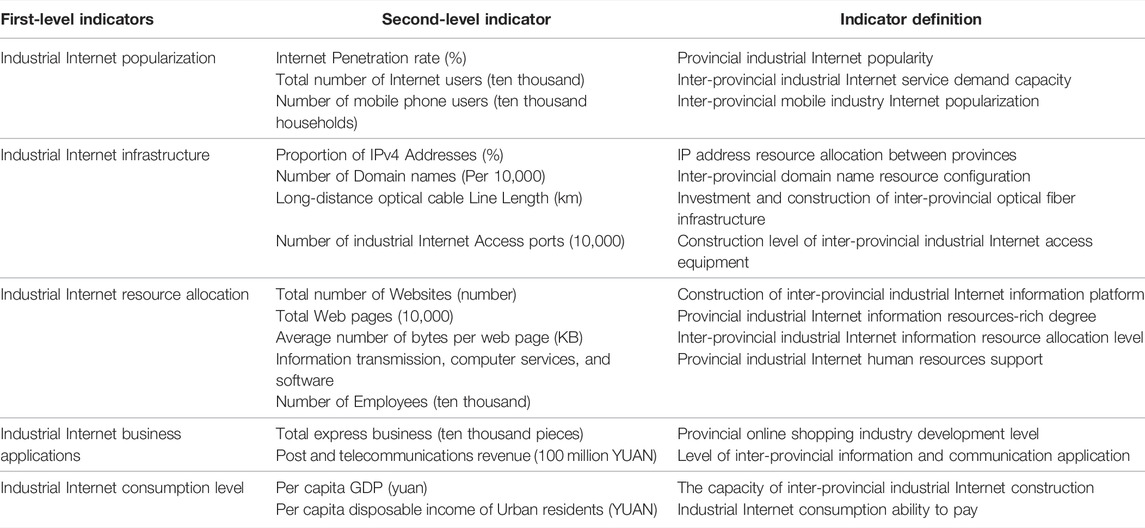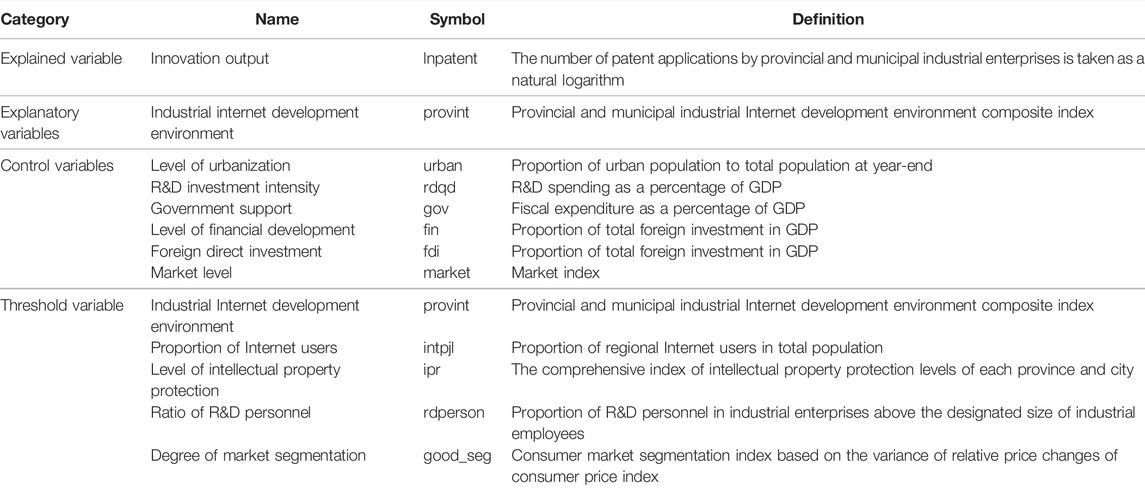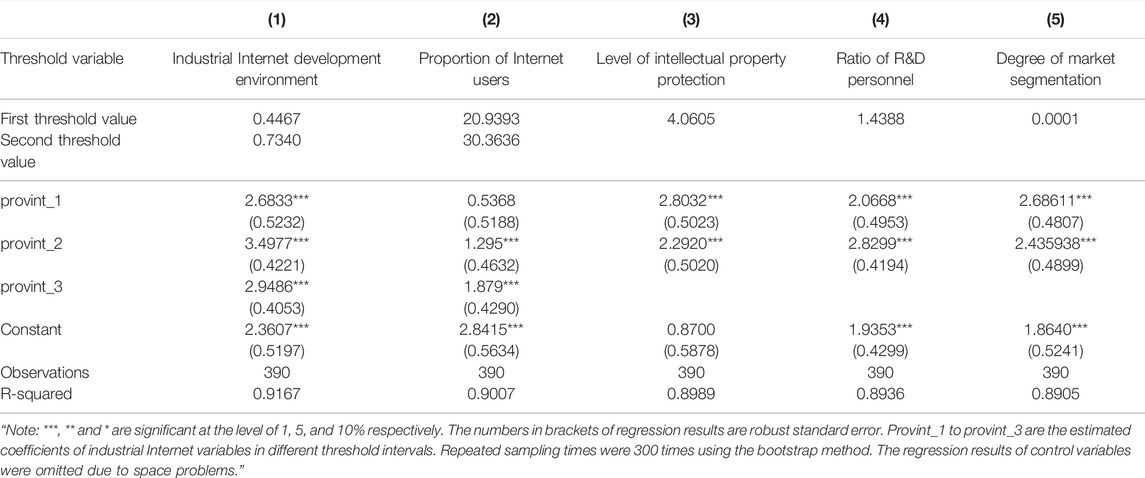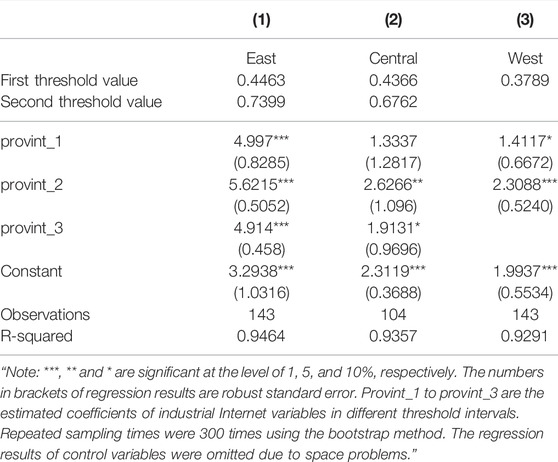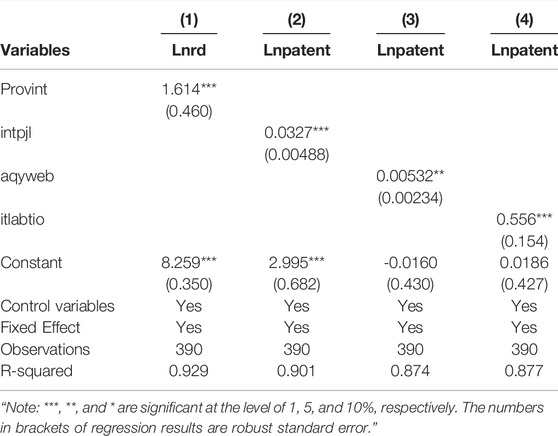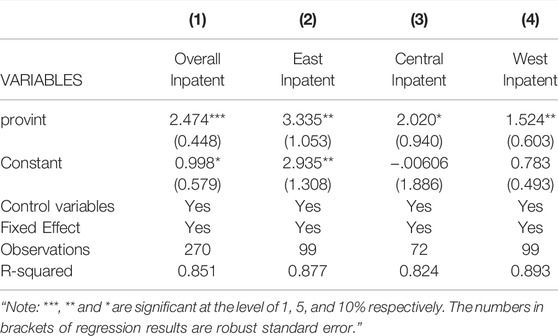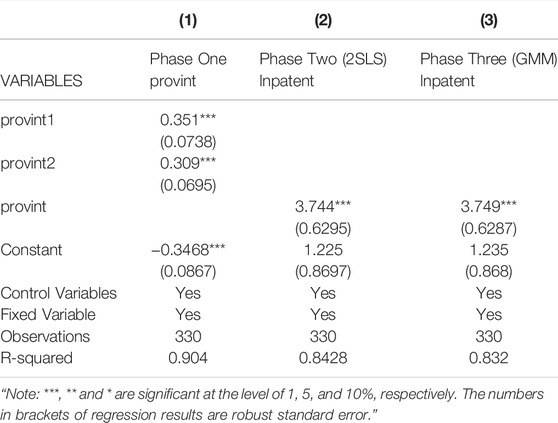- 1School of Economics and Management, Harbin University of Science and Technology, Harbin, China
- 2School of Management, Jiangsu University, Zhenjiang, China
This study aims to expand the research perspective from the micro-enterprise level to the regional environment level to identify changes in the regional industrial Internet environment. The development and application of Industrial Internet technologies formed by these changes have spillover effects on Industrial Internet innovation. Sample data from 30 provinces and big cities of China from 2006 to 2018 were used to verify the network externality characteristics of industrial Internet development. The nonlinear impact of environmental factors, such as the proportion of Internet users and intellectual property protection on the open green innovation of manufacturing enterprises, was investigated through the panel threshold model. Meanwhile, the development level of the industrial Internet in eastern and western China is compared and analyzed. This study contributes to existing knowledge and guides practitioners to help manufacturing organizations develop industrial Internet environments.
1 Introduction
With the explosive development of the new generation of information technology that is gradually extending to the industrial field, the connotation and extension of the industrial Internet further expanded (Karmakar et al., 2019). The resilience of energy infrastructure in the modern economy takes on a new meaning as the convergence of machine automation and data becomes the trademark of Industry 4.0 (Hashriq Dharfizi, 2020). The development of China’s industrial Internet from consumer industrial Internet to industrial Internet will bring a new round of changes (Lee, 2021). China has built a comprehensive modern industrial system, and its manufacturing sector has contributed greatly to the world economy. However, China’s manufacturing industry is growing faster and creating the issues of transformation realizations (Yang and Wang, 2020). The upgrading and high-quality development of the manufacturing industry is based on the new generation of information technology represented by the Internet and the development needs of the new situation of the Fourth Industrial Revolution (Ejsmont et al., 2020). The current industrial Internet has evolved into a complex new super network that will restructure the way manufacturing is organized. As a whole, the manufacturing power network is the depth of industrialization and the key to improving national innovation ability (Yang et al., 2016). To preempt the development opportunity in the new industrial revolution and gain control of the global value chain, the world will have a strategic focus on the use of information technology to assign advanced manufacturing industry development (Ashford and Hall, 2011; Sutawijaya and Nawangsari, 2020; Hu et al., 2022).
Open green innovation is not only the core driving force to promote the transformation and upgrading of the manufacturing industry but also the key to determining the overall strength and competitiveness of the country. From the new development concept to the new development pattern, innovation has never been at the core of China’s overall development. Nowadays, the industrial Internet has entered the era of “technology empowerment,” which has promoted the innovative development of economic society (Nathan and Scobell, 2012). Industrial Internet technology has become an important strategic technology leading a new round of technological revolution and industrial transformation. Moreover, the development and innovation of cutting-edge information and communication technologies will become an important strategic starting point for winning the initiative in global technological competition (Conway, 2016). Industrial Internet has been fully integrated into human production and life and has had a great impact on economic development. Since China formulated the “Industrial Internet plus” action plan in 2015, the integration of the industrial Internet and economic society has become an important trend (Pasquier, 2015). The new generation of ICTs, such as big data, cloud computing, IoT, and artificial intelligence supported by the industrial Internet, is constantly innovating (Seetharaman et al., 2019). The depth and breadth of their integration with the manufacturing industry are constantly improving, and the results are becoming more pronounced (Arnold and Voigt, 2017; Karmakar et al., 2019).
China has advantages such as a huge market scale, a complete industrial system, a solid network foundation, rich application scenarios, and sufficient practical experience (Park, 2019). It needs to create a development path of “Internet + manufacturing” with Chinese characteristics. Practical and academic research in China is necessary. Therefore, this study fully considers the reality of the development of the new generation of IT and distinguishes the dynamic impact of the development stage of the traditional industrial Internet and the new industrial Internet on the open green innovation of Chinese manufacturing enterprises. This research combines theory with practice, quantifies the characteristics of industrial Internet technology in different periods, and summarizes the specific path for industrial Internet to promote open and green innovation in manufacturing enterprises. To fulfill the research gap, this study answers the following key research question.
1.1 What is the Impact of the Industrial Internet Development Environment on the Open Green Innovation of Chinese Manufacturing Enterprises?
Furthermore, it analyzes the heterogeneous impact of the industrial Internet on different types of manufacturing enterprises from the national and regional levels. It contributes to the government's ability to correctly create policies for the deep integration of the industrial Internet and the manufacturing industry. Similarly, the results provide more detailed suggestions for enterprise transformation and upgrading, innovation, and development. The results contribute to the improvement of the industrial innovation system, the high-quality development of the manufacturing industry, and the cultivation of new drivers of economic development. The rest of the manuscript is divided into several sections. Section 2 describes the detailed material and method. Section 3 is about the results and discussion, followed by Section 4, which contains the conclusion and implications of the study.
2 Literature Review
From the global point of view, the industrial Internet has become the common choice of the world’s major countries for the future. The fourth industrial revolution will be the dominant power (Rusly et al., 2020). Nowadays, developed countries have laid out the industrial Internet and China has stood with the developed countries at the same starting line for such a development wave. The industrial Internet is an important means to promote the transformation and upgrading of the traditional manufacturing industry in China (Hu et al., 2022) and a key booster for the development of the digital economy in China. The top-level design goal of China’s industrial Internet is clear, that is, to speed up the construction of new infrastructure, expand integrated and innovative applications, improve the security system, improve the industrial ecological layout, and provide policy support (Beier et al., 2018; Lee, 2021). The shortage of resources and environment of industrial Internet system frame and the significant increase in labor cost have become important factors restricting the development of the manufacturing industry. The manufacturing industry urgently needs technological innovation to drive its development with greater efficiency, lower cost, and more environmentally friendly production management (Luo et al., 2019). At the same time, with the rapid development of information technology, the competitive pattern of the global manufacturing industry has been reshaped. To better grasp the window of opportunity formed by the development of the industrial Internet environment and accelerate the transformation and development of China, the manufacturing industry has become a major subject to promote the development of China’s new economy in the future.
The industrial Internet is closely related to and affects the Internet of Things, big data, information technology, and network security and is the link between the new generation of information technology and advanced industry (Hu et al., 2022; Shahzad et al., 2022). China’s manufacturing base is huge, and the manufacturing industry in the new era is transforming and upgrading from simple scale and quantity expansion to quality and energy efficiency improvement (Chen, 2017). Manufacturing enterprises gradually build industrial Internet subsystems according to their characteristics. The 14th Five-Year Plan is extremely important to China’s economic and social development, leading to high-quality, innovative development, during which China will complete the historic task of building a moderately prosperous society in all respects and embark on a new journey of comprehensively building a modern socialist country (Creemers et al., 2022). At this important historical juncture, China’s economic development has shifted to a stage of high-quality development characterized by innovation-driven development and structural upgrading. In this context, China must seize the strategic opportunities of the new round of scientific and industrial revolution with big data, the Internet of Things, and artificial intelligence at the core. It must enhance independent innovation capacity, conquer key core technologies, promote the advanced industrial base, and build a new development pattern during the 14th Five-Year Plan period (Creemers et al., 2022).
At present, many scholars have conducted research on Internet development, technological innovation, industrial structure transformation, upgrading, etc., but most of them are about the technological innovation effect of technological innovation on Internet development, the adoption of big data, and the structural adjustment effect of green open innovation (Paunov and Rollo, 2016; Shahbaz et al., 2021; Wang and Yang, 2021; Bradu et al., 2022). According to recent development, green innovation has become a prominent focus for academics and specialists. The research simplifies sustainability concerns and decision-making, which is crucial for any company since unsustainable industrial activity leads to the deterioration and depletion of natural resources (Asadi et al., 2020). Transforming industry operations into green innovation practices is difficult for governments and management due to the process’s complexity and ambiguity (Gupta and Barua, 2018). Governments and politicians must adopt long-term policies for proactive environmental protection. As a result, examining green innovation techniques in the business is critical for decreasing environmental harm, increasing quality of life, and supporting national economic development (Wang and Yang, 2021). Therefore, this study is crucial for analyzing the impact of the industrial Internet development environment on open green innovation of manufacturing enterprises mainly focusing on Chinese manufacturing organizations.
3 Material and Method
3.1 Model Building
3.1.1 Benchmark Model Setting
Referring to the model of the relationship between infrastructure construction and open green innovation studied by (Hulten et al., 2006), this research constructs a benchmark model reflecting the impact of regional industrial Internet development environment on open green innovation of manufacturing enterprises, seen in Eq. 1:
where the subscripts j and t represent province j and year t, respectively. The explained variable
3.1.2 Threshold Model Setting
In order to test the nonlinear innovation spillover of the industrial Internet caused by environmental constraints, Hansen’s panel threshold model (1999) is adopted to investigate the nonlinear mechanism, and the model is constructed as follows:
where
3.2 Data Sources and Variable Definitions
3.2.1 Samples and Data Sources
This study takes the regional industrial Internet development environment as the starting point for research and adopts the balanced panel data from 2006 to 2018 at the regional level for empirical analysis; 30 provinces and cities in China were selected as samples. Due to a lack of samples, data from Hong Kong, Macao, Taiwan, and the Tibet Autonomous Region of China were excluded. In this study, the China statistical yearbook of statistical data provided information on:
•open green innovation and R&D manufacturing enterprise to measure the area;
•Internet industry development environment subdivision index data for each year of industry; and
•China Internet development statistics.
The data of other control variables and threshold variables came from the statistics database of the China Economic Network and the local statistical yearbooks of provinces and cities over the years. The intellectual property index also used the data from The Yearbook of Chinese Lawyers and the Annual Report of the State Intellectual Property Office. In addition, in order to reduce the interference of outliers, a 1% tail reduction is also carried out on the samples.
3.2.2 Variable Interpretation
3.2.2.1 Explained Variable
This study adopts the patent application volume of industrial enterprises from each province as the index to measure the innovation output of regional manufacturing enterprises and makes logarithmic processing.
3.2.2.2 Explanatory Variables
At present regarding the regional industrial Internet development environment, the official has not disclosed the more authoritative comprehensive index. Most scholars use a single index to measure the industrial Internet penetration rate, the number of regional netizens, the number of websites, and so on. With the continuous expansion of industrial Internet connotation and extension, a single index can only reflect the local facts of the industrial Internet development environment, in order to fully reflect the regional industrial Internet development environment, also need to measure the comprehensive index. The Internet industry has a comprehensive development level measurement system. According to the availability, comprehensiveness, and scientific nature of data, combined with the actual development of China’s Internet industry, the indicators are defined in Table 1.
In particular, the reasons for the selection of indicators include: (1) the popularity of the industrial Internet. The penetration rate of industrial Internet reflects a province’s netizens’ acceptance of industrial Internet and highlights the potential of the future development of industrial Internet in this province. The scale of Internet users and the number of mobile phone users reflect the demand for industrial Internet service and mobile phone service to a certain extent. These three indicators are also commonly used to measure the development capacity of the industrial Internet, which can reflect the level of industrial Internet popularization at the provincial level. (2) Industrial Internet infrastructure. Four subdivision indicators are selected to comprehensively reflect the infrastructure construction level of industrial Internet: the length of long-distance optical cable lines, the number of access ports, the number of domain names of ten thousand people, and the proportion of IPv4 addresses. (3) Industrial Internet resource allocation. Information is the key element and basic resource in industrial Internet economic activities. Usually rely on websites and web platforms, the information in the form of sound, image, video, and text, to meet the needs of users. Therefore, websites and web pages are important indicators to reflect the level of industrial Internet information resources. In general, the number of websites and web pages directly affects the industrial Internet information resource allocation level. Therefore, the average number of bytes of each web page at the provincial level is selected to represent the level of information resources of web pages. At the same time, talent is also the core resource of the development of the industrial Internet; the number of employees in the information industry affects the development and application of industrial Internet technology.
(4) Industrial Internet business applications. Industrial Internet business applications mainly involve basic communication, social networking, and online shopping. This study reflects the level of business application of the industrial Internet from the perspective of social networking and online shopping, and specifically selects the volume of post and telecommunications business and express business indicators to represent. (5) Industrial Internet consumption level. This part of the regional industrial Internet environment should include its economic environment, consumer environment, and many other aspects. The regional economic environment will be directly related to the construction process of the inter-provincial industrial Internet, the diffusion of use and development direction, purchasing power level, and consumption environment determine the industrial Internet users’ ability to pay for network products and technology and demand willingness. Therefore, in the comprehensive index system of industrial Internet development environment, per capita GDP is added to reflect the economic environment of industrial Internet development, and the per capita consumption level of urban residents is adopted to reflect the consumption environment of industrial Internet development.
Using the principal component analysis method, the annual industrial Internet development environment index
3.2.2.3 Control Variables
Existing studies indicate the main control variables adopted in this part include urbanization level (urban), R&D investment intensity (rdqd), financial support (gov), financial development level (fin), the proportion of foreign investment (FDI), and marketization level (market).
3.2.2.4 Threshold Variables
In this study, the threshold regression model is used to analyze the restricting factors affecting innovation spillover of industrial Internet, and five threshold variables are selected respectively. (1) Industrial Internet Development Environment (provint). Taking the comprehensive index of regional industrial Internet development environment as the threshold variable, the nonlinear effect of regional industrial Internet development environment on innovation spillover can be comprehensively investigated. (2) Penetration rate of the industrial Internet
Among them, the nominal intensity of national intellectual property protection
Secondly, the dimensionless standardization of each secondary index of the actual protection strength
(4) Ratio of R&D personnel (rdperson). Open green innovation is inseparable from the support of human resources. The proportion of science and technology activity personnel in industrial enterprises above the designated size in the number of industrial employees in each province is used to measure the regional labor force structure and human capital level. (5) Market segmentation index (good_seg). The variance of relative price changes of the consumer price index between neighboring provinces was calculated, and the market segmentation index of each province was obtained. To explore whether market segmentation will hinder the free flow of factors of production across time and space in the industrial Internet environment. Based on the above analysis, the definitions of the main variables in this study are summarized, as shown in Table 3.
4 Results and Discussions
In this section, the benchmark and threshold models are used for regression, respectively, to comprehensively investigate the impact of the industrial Internet development environment on the open green innovation of manufacturing enterprises.
4.1 Descriptive Statistics
Table 4 describes the descriptive statistics of the main variables. The statistical results show that the logarithmic mean and standard deviation of the patent number of industrial enterprises in each province and city are 8.424 and 1.652, indicating that there are great differences in the level of open green innovation in different regions. The average value of the industrial Internet development environment composite index is 0.589, and the overall network environment level is above medium, but there are still differences between different regions of the industrial Internet development environment. As can be seen from the proportion of regional industrial Internet users, the minimum value is 3.848, the maximum value is 77.99, and the average value is 39.06. It can be seen that the regional industrial Internet popularity and basic environment in the sample range show great development and change.
Figure 1 shows the variation trend of the industrial Internet development environment composite index of provinces and cities from 2006 to 2018. The development level of the industrial Internet environment in most provinces shows an upward trend of fluctuation, but there is a relatively obvious “digital divide,” which is mainly reflected in 1) Beijing, Shanghai, Guangdong, Jiangsu, and other eastern provinces and cities that have a high level of industrial Internet development, generally exceeding 0.8, showing an obvious growth trend, and these regions account for 26.67% of the national proportion. 2) Including Anhui, Jiangxi, Jilin, seven provinces in central and western provinces except in Sichuan, Chongqing, and Hainan, a total of 18 provinces industrial development of the Internet environment comprehensive index is a phenomenon of continued growth, but they were always lower than during the same period. The level of the Internet industry, the province accounted for more than 60%, mainly concentrated in the Midwest. 3) The level of the industrial Internet in Sichuan, Chongqing, Henan, Hebei, and other provinces and cities continues to grow, with a certain trend of lagging behind. 4) Since 2011, the development level of the industrial Internet in Inner Mongolia, Guizhou, Ningxia, Guangxi, Qinghai, and other regions has risen sharply several times. During this period, the state has intensified the strategy of poverty alleviation, western development, and the rise of central China, which may have played a driving role in the development of the industrial Internet in these regions.
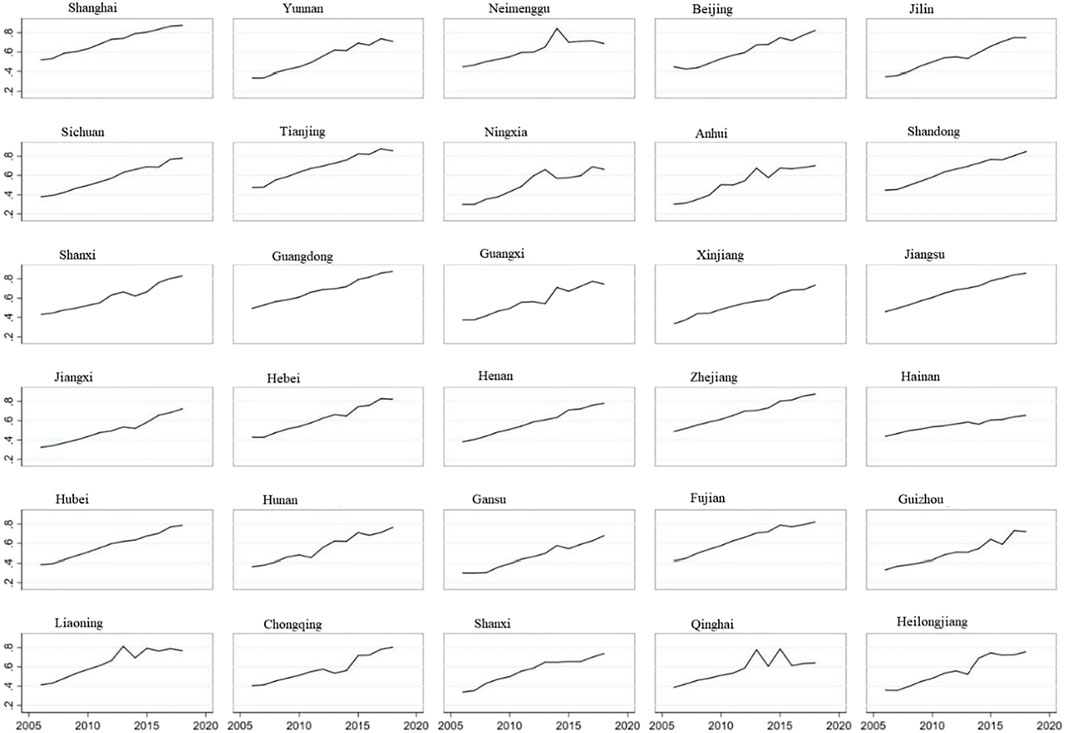
FIGURE 1. Trend of industrial Internet development environment composite index of provinces and cities from 2006 to 2018. (Source: Drawing using Stata software).
4.2 The Existence Test of Environmental Impact Effect of Industrial Internet Development
The benchmark regression results of innovation spillover effects in the industrial Internet development environment are shown in Table 5, which adopts the fixed panel model and add control variables and individual fixed effects. The results show that the industrial Internet development environment can promote the open green innovation of regional manufacturing enterprises, and the influence coefficient is 2.726, which is significantly positive at the confidence level of 1%. According to the division of the three economic zones, the spillover effect of industrial Internet innovation in eastern provinces and cities is the largest and most significant, with an impact coefficient of 3.798, followed by the central and western provinces with an impact coefficient of 2.089 and 1.538, respectively.
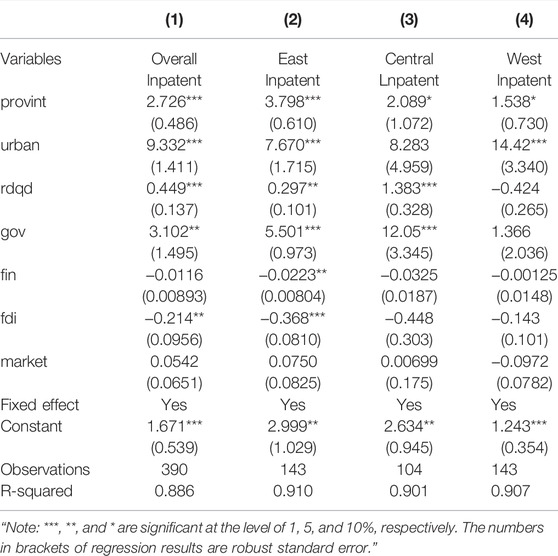
TABLE 5. Benchmark regression results of innovation spillover effect in an industrial Internet development environment.
In terms of control variables, the higher the level of urbanization , the higher the level of open green innovation. It can be seen that the increase of the non-agricultural population provides innovative human resources for innovation activities, thus promoting innovation. Thus, the urbanization process in western provinces has the greatest impact on innovation. The intensity of R&D investment and financial support have a significant positive effect on the open green innovation of manufacturing enterprises, while the influence coefficient of foreign investment is negative, indicating that FDI has a certain crowding out effect on the local open green innovation. Financial development and marketization level have no significant impact on open green innovation in the manufacturing industry.
4.3 Threshold Model Testing
In this part, the comprehensive index of the industrial Internet development environment, the proportion of Internet users, intellectual property protection, the proportion of research and development personnel, and the degree of market segmentation are taken as the threshold variables and added into the threshold model for analysis. The test results are shown in Table 6. First, check whether the threshold effect is significant. Among them, the industrial Internet development environment composite index and the proportion of Internet users in the study sample contain two threshold values. The level of intellectual property protection, the proportion of R&D personnel, and the degree of market segmentation are significant only in a single threshold test.
Next, the threshold model is used to influence the open green innovation of manufacturing enterprises by industrial Internet. The regression results of threshold values are based on different influencing factors, as shown in Table 7, reflecting the nonlinear characteristics of the industrial Internet innovation spillover effect.
4.3.1 Industrial Internet Development Environment
The influence of the industrial Internet development environment composite index on the open green innovation of manufacturing enterprises presents the characteristics of double thresholds. When the regional industrial Internet development environment composite index is lower than 0.4467 to equal to and over 0.734, the impact coefficient of industrial Internet on open green innovation of manufacturing enterprises increases from 2.6833 to 3.4977 and then decreases to 2.9486. This result verifies the inverted U-shaped nonlinear influence of the industrial Internet development environment on its innovation spillover effect. The development environment of the industrial Internet has a positive spillover effect on the open green innovation of manufacturing enterprises, and this innovation spillover effect exists in the optimal range. Beyond this range, the innovation spillover effect of the industrial Internet still exists but shows a weakening trend.
It should be pointed out that as a threshold variable, the comprehensive index of the industrial Internet development environment has different influences on the spillover effect of industrial Internet innovation in the east, central and western regions. The test results of the threshold model by region are shown in Table 8. In order to realize the optimal industrial Internet spillover effect, the first threshold value to be crossed is 0.4463 in eastern provinces, 0.4366 in central provinces, and 0.3789 in western provinces. Relatively speaking, western provinces and cities to obtain industrial Internet innovation spillover only need to cross the low threshold of the industrial Internet environment.
4.3.2 Proportion of Internet Users
The ratio of Internet users to the proportion of Internet users presents a double threshold effect on the open green innovation of manufacturing enterprises, and the corresponding two thresholds are 20.9393 and 30.3636, respectively. When the proportion of regional Internet users is less than 20.9%, the influence coefficient of industrial Internet on manufacturing enterprises is not significant. When crossing this threshold, the influence coefficient of industrial Internet on manufacturing enterprises reaches 1.295, which is significantly positive in the 1% confidence interval. When the proportion of Internet users is greater than 30.4%, the influence coefficient of the industrial Internet on open green innovation of manufacturing enterprises further increased to 1.879, which verifies the network effect of the industrial Internet, that is, the innovation spillover effect of the industrial Internet will increase with the increase of Internet users.
4.3.4 Level of Intellectual Property Protection
The level of regional intellectual property protection is positively correlated with the open green innovation of manufacturing enterprises caused by the industrial Internet, and there is a single threshold effect. When the intellectual property protection index is lower than 4.0605, the impact coefficient of industrial Internet on the open green innovation of manufacturing enterprises is 2.8032, which is significantly positive in the 1% confidence interval. When crossing this threshold value, the impact coefficient of industrial Internet decreases to 2.2920, but it is still significantly positive. The results reflect that the industrial Internet still has a significant innovation spillover effect under intellectual property protection, but the innovation impact coefficient of the industrial Internet decreases with the increase of intellectual property protection intensity. According to theoretical analysis, this phenomenon does not indicate that intellectual property rights inhibit the innovation spillover effect of the industrial Internet but regulate innovation activities of the industrial Internet through laws and regulations. The average level of intellectual property rights protection in each province from 2006 to 2018 was 2.291, which is still in the development stage.
4.3.5 Ratio of R&D Personnel
The proportion of regional R&D personnel positively correlated with the spillover effect of industrial Internet innovation, and there is a single threshold effect. When the proportion of R&D personnel is lower than 1.4388%, the impact coefficient of industrial Internet on open green innovation of manufacturing enterprises is 2.0668, which is significantly positive in the 1% confidence interval. When crossing this threshold value, the impact coefficient of the industrial Internet increases to 2.8299. The results show that the higher the level of regional human capital, the more conducive to the industrial Internet to open green innovation of enterprises to play a positive role.
4.3.6 Degree of Market Segmentation
The degree of market segmentation reflects whether local governments restrain resource flows by controlling local resources. Market segmentation will restrict the cross-regional flow of enterprise innovation resources in the industrial Internet environment. The empirical results show that when the market segmentation index is higher than 0.0001, the Internet industry to the manufacturing enterprise of open green innovation influence coefficient dropped to 2.4359 and is significant at a 1% confidence interval. Regional protectionism or resource monopoly constrain industrial Internet innovation spillovers and hinder the cross-regional cooperation innovation. To give full play to network externalities, regional barriers should be broken, and market integration promoted.
4.4 Robustness Test
4.4.1 Change Explanatory Variable and Explained Variable
In order to further verify the reliability and robustness of the study, the explanatory variables and explained variables were changed respectively for regression analysis. The explained variable was replaced by innovation input, that is, R&D expenditure of industrial enterprises, to represent the level of open green innovation in the manufacturing industry. The explanatory variable was changed from a comprehensive index to a single index, and the penetration rate of the industrial Internet, the ratio of the total number of websites to the number of enterprise units, and the proportion of the information industry employees were used as the replacement index of the industrial Internet development environment index in each province to carry out robust estimation. The regression results are shown in Table 9. The impact of different industrial Internet indicators on manufacturing innovation is still significant.
4.4.2 Adjusted Sample Interval
By adjusting the sample interval, the period from 2008 to 2016 was selected as the research period for re-testing, and the robustness was further tested through regression tests in the eastern, central, and western regions. The results are shown in Table 10. The development environment of industrial Internet still has a significant promoting effect on the open green innovation of manufacturing enterprises, and the spillover effect of industrial Internet innovation in the eastern, central, and western regions is significant and different, which is consistent with the previous research results.
4.4.3 Endogeneity Testing: Instrumental Variable Method
In this study, an endogeneity test is performed. Provint tool variables with one and two lags were selected, and the 2SLS model and GMM model with fixed effects were used for regression, respectively. Test results are shown in Table 11.
In the first stage, the lag of one and two stages of the industrial development of the Internet have a significantly positive influence on the environment. In the second stage, the Internet industry development environment for open green innovation influence coefficient is positive, consistent with the above conclusion, 2 SLS and GMM estimation results is no an obvious difference. At the same time, the provint variable passes the over-identification test, and the Sargan test cannot reject the null hypothesis that the provint variable is valid, indicating that the choice of the tool variable is reasonable.
5 Conclusion
5.1 Contribution of the Study
Based on the data of 30 provinces and cities from 2006 to 2018, this study examines the impact of the industrial Internet development environment on the open green innovation of manufacturing enterprises by constructing the regional industrial Internet development environment index system and measuring the comprehensive index of the regional industrial Internet development environment. The core contributions of the study are as follows: First, the comprehensive index of the industrial Internet development environment of all provinces and cities shows an upward trend of fluctuation, but there is an obvious “digital divide.” The development environment of the industrial Internet in eastern China is generally better, showing an obvious leading growth trend, while the development environment of the industrial Internet in central and western China is relatively backward. However, in recent years, the development speed of industrial Internet in western provinces such as Sichuan and Chongqing are obviously accelerated, and there is a certain phenomenon of “catching up and surpassing.” Secondly, the regional industrial Internet development environment has a significant promotion effect on the open green innovation of manufacturing enterprises, presenting an obvious innovation spillover effect. The spillover effect of industrial Internet innovation is different in the east and the central and western regions. The east is the most significantly affected by the industrial Internet, followed by the central and western regions.
Third, there is a nonlinear transmission mechanism of the impact of the industrial Internet development environment on the open green innovation of manufacturing enterprises. By taking the industrial Internet development environment, the proportion of Internet users, the level of intellectual property protection, the proportion of R&D personnel, and the degree of market segmentation as the threshold variables to test the threshold model. The industrial Internet development environment and the proportion of Internet users have a double threshold effect, and the intensity of intellectual property protection, the proportion of R&D personnel, and the degree of market segmentation have a single threshold effect. The development environment of the industrial Internet has an inverted U-shaped nonlinear influence on its innovation spillover effect. Similarly, the eastern provinces need to overcome the threshold value of the industrial Internet development environment to achieve the optimal innovation spillover effect. Meanwhile, the western industrial Internet development environment has a relatively low threshold constraint, which provides a “late-comer advantage” for the improvement of the western manufacturing innovation level. The innovation spillover effect of the industrial Internet will increase with the increase of Internet users, which verifies the network externality of the industrial Internet. Under the protection of intellectual property rights, the industrial Internet significant innovation spillover effect still exists, but with the increase of the intensity of the protection of intellectual property rights. The innovation of the reduced industrial Internet influence coefficient may lead to an information security risk through the Internet intellectual property laws and regulations and standard industry innovation. To some extent, it will lead to a decline in the number of open green innovations.
Finally, the innovation spillover of the industrial Internet development environment is also affected by the proportion of R&D personnel and the market segmentation index. When the proportion of R&D personnel is higher than 1.4388%, the innovation promotion effect of the industrial Internet on manufacturing enterprises is improved. When the market segmentation index is higher than 0.0001, the influence coefficient of industrial Internet on open green innovation of manufacturing enterprises decreases, indicating that inter-regional protectionism will constrain the spillover effect of industrial Internet innovation . Therefore, enterprises should continue to play an innovative role in R&D and encourage manufacturing enterprises to adapt to the industrial Internet development environment and the new digital economy, and make full use of the new generation of information technology to achieve competitive advantages.
In addition to the management significance, this research also has certain theoretical contributions, such as the research results that can contribute to the existing industrial Internet development literature. At the same time, this study also helps form a deeper understanding of the role of industrial Internet development in green and open innovation. It enables scholars to carry out specific theoretical development and understanding of this concept, which helps to understanding this concept more clearly. Furthermore, the proposed model can provide a bird’s-eye view, allowing future scholars to link existing models for future development.
5.2 Limitations and Future Directions
In addition to research significance, this study also has some limitations for future scholars to resolve. First, this study establishes a model based only on China’s manufacturing organization. The scope of results may be affected. Therefore, it is recommended that future scholars adopt the model on a global scale and test it in other industries, such as high-tech enterprises. Comparative analysis will provide a broader perspective for understanding the importance of the industrial Internet development environment. Second, futurologists can accelerate the innovation of artificial intelligence, cloud computing, cutting-edge computing, and other technical basic theories and improve the diversified long-term effect mechanism that was not involved in this study.
Finally, due to the availability of data, the complete dataset from 2006 to 2018 was analyzed in this study. Future researchers can add the maximum available data from a different context and analyze different time lags.
Data Availability Statement
Publicly available datasets were analyzed in this study. This data can be found here: China statistical yearbook of science and technology.
Author Contributions
RH: Conceptualization, Writing—original draft preparation, Data curation, Software, Formal analysis. FS: Supervision, Methodology, Project administration. AA: Data Curation, Visualization, Writing—review, and Editing. NX: Methodology, Formal analysis. All the authors read and approved the manuscript for submission.
Conflict of Interest
The authors declare that the research was conducted in the absence of any commercial or financial relationships that could be construed as a potential conflict of interest.
Publisher’s Note
All claims expressed in this article are solely those of the authors and do not necessarily represent those of their affiliated organizations or those of the publisher, the editors, and the reviewers. Any product that may be evaluated in this article, or claim that may be made by its manufacturer, is not guaranteed or endorsed by the publisher.
References
Arnold, C., and Voigt, K.-I. (2017). Ecosystem Effects of the Industrial internet of Things on Manufacturing Companies. Acta Infologica 1, 99–108.
Asadi, S., OmSalameh Pourhashemi, S., Nilashi, M., Abdullah, R., Samad, S., Yadegaridehkordi, E., et al. (2020). Investigating Influence of Green Innovation on Sustainability Performance: A Case on Malaysian Hotel Industry. J. Clean. Prod. 258, 120860. doi:10.1016/j.jclepro.2020.120860
Ashford, N. A., and Hall, R. P. (2011). The Importance of Regulation-Induced Innovation for Sustainable Development. Sustainability 3, 270–292. doi:10.3390/su3010270
Beier, G., Niehoff, S., and Xue, B. (2018). More Sustainability in Industry through Industrial internet of Things? Appl. Sci. 8, 219. doi:10.3390/app8020219
Bradu, P., Biswas, A., Nair, C., Sreevalsakumar, S., Patil, M., Kannampuzha, S., et al. (2022). Recent Advances in Green Technology and Industrial Revolution 4.0 for a Sustainable Future. Environ. Sci. Pollut. Res., 1–32. doi:10.1007/s11356-022-20024-4
Chen, Y. (2017). Integrated and Intelligent Manufacturing: Perspectives and Enablers. Engineering 3, 588–595. doi:10.1016/J.ENG.2017.04.009
Conway, J. (2016). The Industrial internet of Things: An Evolution to a Smart Manufacturing Enterprise. Available at: http://zift-automation.s3.amazonaws.com/APC/Showcase/The_Industrial_Internet_of_Things_An_Evolution_to_a_Smart _Manufacturing_Enterprise.pdf.
Creemers, R., Dorwart, H., Neville, K., Schaefer, K., Costigan, J., and Webster, G. (2022). Translation: 14th Five-Year Plan for National Informatization. Digichina. Available at: https://digichina.stanford.edu/work/translation-14th-five-year-plan-for-national-informatization-dec-2021/#:∼:text=The (Accessed March 22, 2022).
Ejsmont, K., Gladysz, B., and Kluczek, A. (2020). Impact of Industry 4.0 on Sustainability-Bibliometric Literature Review. Sustainability 12, 5650. doi:10.3390/su12145650
Gupta, H., and Barua, M. K. (2018). A Grey DEMATEL-Based Approach for Modeling Enablers of Green Innovation in Manufacturing Organizations. Environ. Sci. Pollut. Res. 25, 9556–9578. doi:10.1007/s11356-018-1261-6
Hashriq Dharfizi, A. D. (2020). The Energy Sector and the Internet of Things - Sustainable Consumption and Enhanced Security through Industrial Revolution 4.0. J. Int. Stud 14, 99–117. doi:10.32890/jis.14.2018.8001
Hu, R., Shahzad, F., Abbas, A., and Liu, X. (2022). Decoupling the Influence of Eco-Sustainability Motivations in the Adoption of the Green Industrial IoT and the Impact of Advanced Manufacturing Technologies. J. Clean. Prod. 339, 130708. doi:10.1016/j.jclepro.2022.130708
Hulten, C. R., Bennathan, E., and Srinivasan, S. (2006). Infrastructure, Externalities, and Economic Development: A Study of the Indian Manufacturing Industry. World Bank. Econ. Rev. 20, 291–308. doi:10.1093/wber/lhj007
Karmakar, A., Dey, N., Baral, T., Chowdhury, M., and Rehan, M. (2019). “Industrial internet of Things: A Review,” in 2019 International Conference on Opto-Electronics and Applied Optics, Optronix, Kolkata, India, 18-20 March 2019 (IEEE), 1–6. doi:10.1109/OPTRONIX.2019.8862436
Lee, J. (2021). The Connection of Everything: China and the Internet of Things. Available at: https://merics.org/en/report/connection-everything-china-and-internet-things.
Luo, W., Wang, H., and Zheng, S. (2019). Internet Infrastructure and Industrial Development in China. SSRN J, 3484081. doi:10.2139/ssrn.3484081
Nathan, A. J., and Scobell, A. (2012). How China Sees America. Foreign Aff. 91, 40–46. doi:10.1017/CBO9781107415324.004
Park, J. (2019). Advances in Future Internet and the Industrial internet of Things. Symmetry 11, 244. doi:10.3390/sym11020244
Pasquier, M. (2015). INTERNET PLUS: CHINA’S OFFICIAL STRATEGY FOR THE UBERISATION OF THE ECONOMY. Available at: https://innovationiseverywhere.com/internet-plus-chinas-official-strategy-for-the-uberisation-of-the-economy/ (Accessed April 22, 2022).
Paunov, C., and Rollo, V. (2016). Has the Internet Fostered Inclusive Innovation in the Developing World? World Dev. 78, 587–609. doi:10.1016/j.worlddev.2015.10.029
Rusly, F. H., Taliba, Y. Y. A., Abd Mutaliba, H., and Hussina, M. R. A. (2020). “Developing a Digital Adaptation Model for Malaysian Manufacturing SMEs,” in 4th UUM International Qualitative Research Conference (QRC 2020), Virtual Conference, 1–3 December 2020, 1–3.
Seetharaman, A., Patwa, N., Saravanan, A. S., and Sharma, A. (2019). Customer Expectation from Industrial internet of Things (IIOT). Jmtm 30, 1161–1178. doi:10.1108/JMTM-08-2018-0278
Shahbaz, M., Gao, C., Zhai, L., Shahzad, F., and Khan, I. (2021). Environmental Air Pollution Management System: Predicting User Adoption Behavior of Big Data Analytics. Technol. Soc. 64, 101473. doi:10.1016/j.techsoc.2020.101473
Shahzad, F., Du, J., Khan, I., and Wang, J. (2022). Decoupling Institutional Pressure on Green Supply Chain Management Efforts to Boost Organizational Performance: Moderating Impact of Big Data Analytics Capabilities. Front. Environ. Sci. 10, 1–13. doi:10.3389/fenvs.2022.911392
Sutawijaya, A. H., and Nawangsari, L. C. (2020). What Is the Impact of Industry 4.0 to Green Supply Chain? J. Environ. Treat. Tech. 8, 207–213.
Wang, Y., and Yang, Y. (2021). Analyzing the Green Innovation Practices Based on Sustainability Performance Indicators: a Chinese Manufacturing Industry Case. Environ. Sci. Pollut. Res. 28, 1181–1203. doi:10.1007/s11356-020-10531-7
Yang, C., Shen, W., and Wang, X. (2016). “Applications of Internet of Things in Manufacturing,” in The 20th IEEE International Conference on Computer Supported Cooperative Work in Design (CSCWD 2016), Nanchang, Jiangxi, China, May, 2016, 670–675. doi:10.1109/CSCWD.2016.7566069
Keywords: green innovation, industrial Internet, technology, open innovation, intellectual property
Citation: Hu R, Shahzad F, Abbas A and Xu N (2022) Empirical Analysis of the Impact of Industrial Internet Development Environment on Open Green Innovation of Manufacturing Enterprises. Front. Environ. Sci. 10:947675. doi: 10.3389/fenvs.2022.947675
Received: 19 May 2022; Accepted: 31 May 2022;
Published: 11 July 2022.
Edited by:
Zeeshan Fareed, Huzhou University, ChinaReviewed by:
Muhammad Atif Nawaz, Islamia University of Bahawalpur, PakistanSidra Ghazanfar, Khwaja Fareed University of Engineering and Information Technology (KFUEIT), Pakistan
Copyright © 2022 Hu, Shahzad, Abbas and Xu. This is an open-access article distributed under the terms of the Creative Commons Attribution License (CC BY). The use, distribution or reproduction in other forums is permitted, provided the original author(s) and the copyright owner(s) are credited and that the original publication in this journal is cited, in accordance with accepted academic practice. No use, distribution or reproduction is permitted which does not comply with these terms.
*Correspondence: Rui Hu, eWl5b25nZXJAMTYzLmNvbQ==; Fakhar Shahzad, ZnNoYWh6YWQ1MUB1anMuZWR1LmNu
 Rui Hu1*
Rui Hu1* Fakhar Shahzad
Fakhar Shahzad Adnan Abbas
Adnan Abbas Nan Xu
Nan Xu